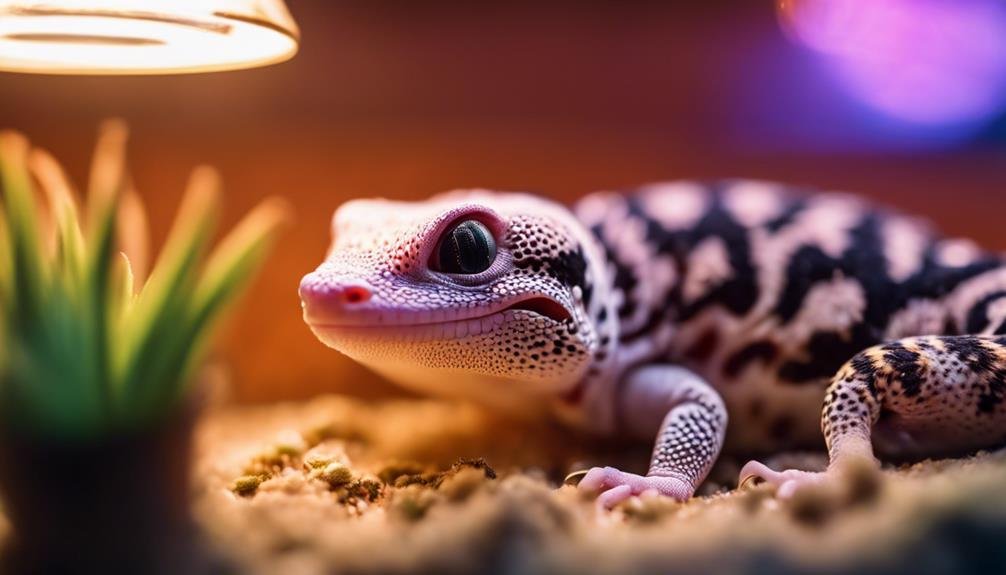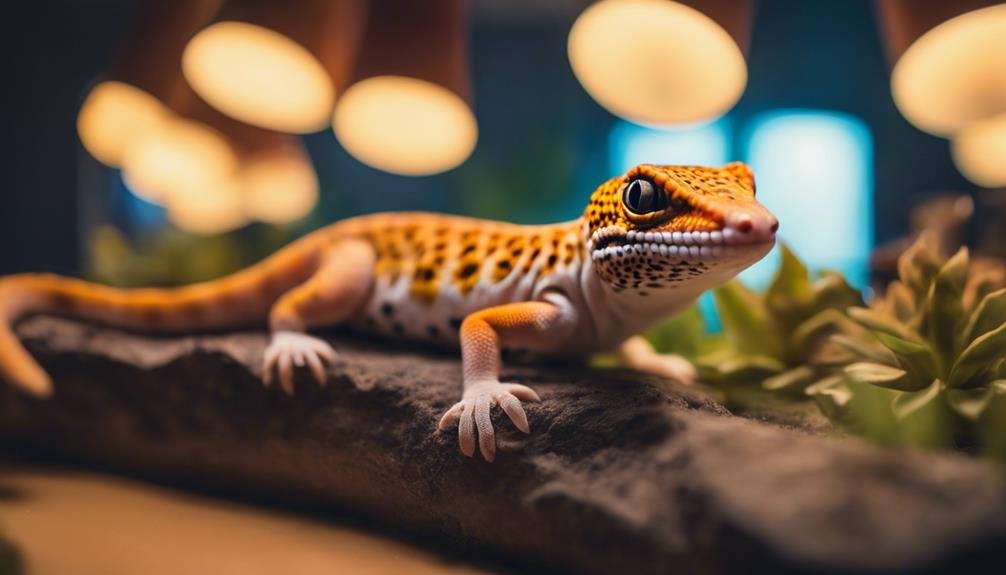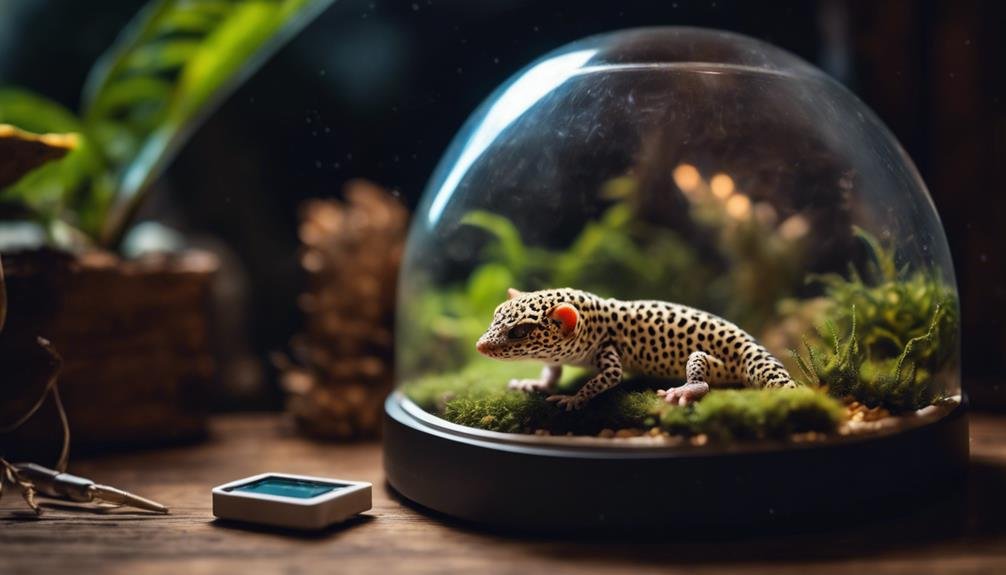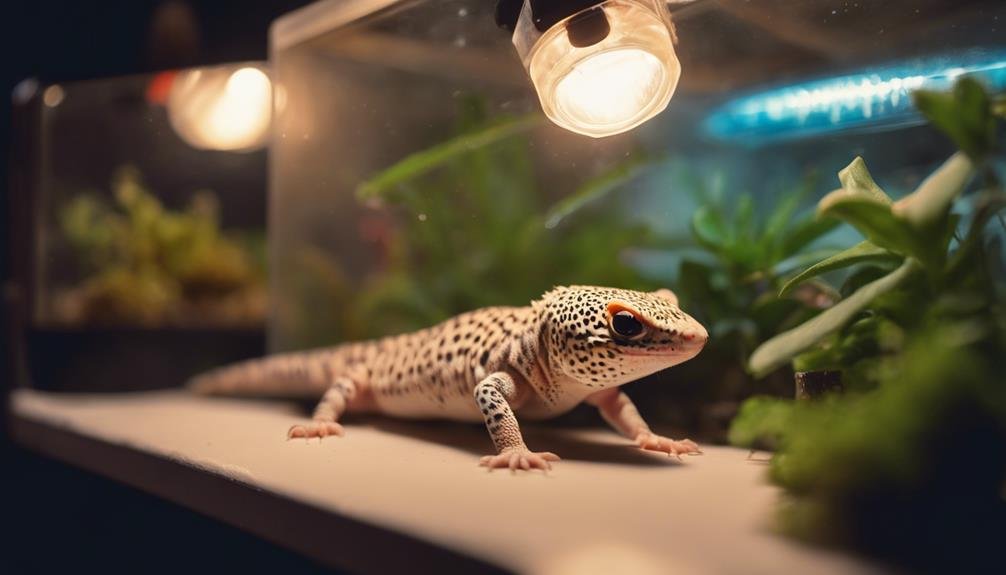If you've ever wondered whether your leopard gecko needs a heat lamp, you're not alone. These fascinating reptiles require specific temperatures to thrive, ranging from a basking area of 94-97°F during the day to a cooler 60°F at night. Without the right heat source, they can face a host of health issues, not to mention disruptions in their natural brumation cycle. But before you rush out to buy any heat lamp, it's important to understand the balance between providing warmth and avoiding overheating, as well as exploring alternative heating solutions. Curiosity may lead you to uncover how these temperature requirements affect their overall well-being and behavior, a topic rich with insights for any leopard gecko enthusiast.
Key Takeaways
- Leopard geckos require a heat lamp to maintain a basking area of 94-97°F for proper digestion and activity.
- A drop in nighttime temperature to around 60°F mimics natural conditions and supports healthy brumation cycles.
- Heat lamps help prevent health issues by keeping the gecko warm, thereby avoiding lethargy and digestive problems.
- Properly chosen and positioned heat lamps prevent overheating, ensuring a comfortable and safe environment for the gecko.
- In addition to heat lamps, under-tank heaters or heat mats can provide a stable temperature gradient, essential for leopard gecko well-being.
Understanding Brumation
Brumation, akin to hibernation, is an important rest period for leopard geckos during winter, essential for their reproductive health. This dormancy phase mirrors the cooling temperatures of their natural habitat, preparing them for the breeding season ahead. It's crucial to understand that not all geckos should undergo brumation; only those that are healthy and have been well-fed can safely enter this state without significant health risks.
Preparing for brumation involves more than just letting your gecko's tank cool down. You've got to closely monitor their health and make gradual temperature adjustments to mimic the natural decrease in temperature they'd experience in the wild. This slow transformation helps minimize stress on your gecko and reduces the risk of health complications.
Different gecko species have specific needs when it comes to the ideal cooling temperatures for brumation. It's not a one-size-fits-all scenario. You'll need to research and make sure you're providing the right conditions for your specific gecko species. Proper preparation and monitoring are key to a successful brumation period, setting the stage for your gecko's reproductive success once they awaken.
Essential Temperature Ranges
You need to know the right temperature ranges during the day and night for your leopard gecko's habitat.
During the day, their basking area should be warm, between 94-97°F, and at night it's safe for the temperature to drop to around 60°F.
This temperature gradient is essential for their health and mimics their natural environment.
Optimal Daytime Temperatures
What're the ideal daytime temperatures for your leopard gecko's health and comfort? Ensuring the right temperature is important for their well-being, as Leopard Geckos rely on external heat sources to regulate their body temperature. Here's a simple guide:
- Basking Surface Temperature: Keep it between 94-97°F. This warm spot enables your gecko to thermoregulate effectively during the day.
- Warm Hide Area: Maintain this space at 90-92°F. It's essential for providing a consistent warm environment where your gecko can retreat.
- Cool End Temperature: Ensure a range of 70-77°F. This cooler area allows your gecko to escape the heat and is crucial for their comfort.
Nighttime Temperature Drop
After exploring how daytime temperatures impact your leopard gecko's habitat, let's now focus on the importance of allowing for a cooler environment during the night. Leopard geckos require a nighttime temperature drop down to 60°F to maintain their health.
Ensuring proper night tolerance temperature ranges is essential for their comfort and well-being. Utilizing appropriate heating sources at night is necessary for maintaining these nighttime temperature ranges, supporting consistent nighttime temperature regulation.
This drop not only simulates their natural habitat, promoting healthy behaviors but is also key to their overall vitality. By providing a suitable environment that includes a proper night tolerance temperature, you're ensuring your leopard geckos can thrive, exhibiting natural and healthy behaviors.
Heat Lamp Benefits


Heat lamps offer essential warmth that enables leopard geckos to effectively regulate their body temperature. By mimicking the natural sun exposure these creatures would enjoy in the wild, heat lamps fulfill an important role in their captive environment. Properly positioned within the habitat, they not only guarantee your gecko stays active but also greatly reduce the risk of common health issues.
Here's how heat lamps benefit your leopard gecko:
- Creates a Basking Spot: Essential for thermoregulation, the basking spot allows your gecko to warm up for ideal digestion and activity levels. Without this, they can become lethargic and face digestive challenges.
- Mimics Natural Sun Exposure: This is key to simulating a natural environment, encouraging normal behavior, and supporting physiological health. It's about more than warmth; it's about providing a setting that feels like home.
- Prevents Health Issues: Proper heat gradients prevent respiratory problems and other health concerns by ensuring your gecko can always find a comfortable temperature. Proper placement of the heat lamp is crucial to avoid hotspots that could cause discomfort or harm.
Health Risks of Cold
When your leopard gecko isn't kept warm enough, you're not just making them uncomfortable; you're putting their health at risk. Cold temperatures can lead to a decline in their immune system and disrupt their metabolic processes.
It's essential to understand how these risks can affect your pet's well-being and the importance of proper heating.
Immune System Decline
Exposing your leopard gecko to cold temperatures can greatly weaken its immune system, leaving it vulnerable to various illnesses. The drop in temperature affects their health in several critical ways, greatly increasing the risk of respiratory infections, decreasing their appetite, and causing lethargy.
To guarantee your leopard gecko remains healthy and active, consider the following:
- Maintain Ideal Temperature: Make sure their habitat is properly heated to support their metabolism and prevent immune system decline.
- Monitor Appetite Changes: A decrease in appetite could indicate inadequate heating and health issues.
- Watch for Lethargy: Sluggishness may signal a weakened immune system or the onset of brumation, which can be detrimental if not properly managed.
Metabolic Process Disruption
Inadequate heating disrupts the metabolic processes of leopard geckos, leading to serious health risks including sluggishness and decreased appetite. When you don't provide proper heating, these cold-blooded creatures can't regulate their body temperature, making them vulnerable to cold temperatures. This not only slows down their metabolism but also increases the risk of digestive issues and respiratory infections due to a weakened immune system.
To make sure your leopard gecko stays healthy and active, it's vital to maintain a warm environment. Cold temperatures can lead to a host of problems, from decreased appetite to potential dangers during brumation periods. By avoiding cold and guaranteeing proper heating, you're safeguarding your leopard gecko against these health risks, keeping their metabolic processes running smoothly.
Choosing the Right Heat Lamp


Selecting the appropriate heat lamp is essential to make sure your leopard gecko enjoys the proper basking temperature of 94-97°F. With the right setup, you can guarantee their habitat isn't just comfortable but also conducive for their health and well-being. Understanding the essentials of heat lamp selection can greatly impact their environment by preventing brumation and promoting a natural day-night cycle.
Here are three important points to take into account when choosing a heat lamp for your leopard gecko:
- Wattage and Bulb Type: Opt for a heat lamp with the appropriate wattage to maintain the basking temperature. Halogen bulbs or ceramic heat emitters are ideal as they provide deep core heating without disrupting your gecko's sleep cycle.
- Distance and Regulation: The distance between the heat lamp and the tank should be adjusted to prevent overheating. Use thermostats specifically designed for heat lamps to keep the temperature within the desired range.
- Promoting Natural Cycles: By choosing the right heat lamp, you help support your leopard gecko's natural day-night cycle, essential for their overall health and preventing unwanted brumation.
Alternative Heating Solutions
Beyond traditional heat lamps, you'll find several alternative heating solutions to keep your leopard gecko cozy and healthy. One efficient option involves under-tank heaters, which provide a steady source of warmth from below, closely mimicking the natural heat geckos would experience from sun-warmed surfaces in the wild.
When you're looking to avoid the light emitted by heat lamps, especially during the night, ceramic heat emitter bulbs come in handy. These bulbs screw into standard reflector domes and emit heat without light, maintaining the perfect nighttime ambiance for your gecko.
Combining heat lamps with heat mats under a portion of the tank can offer deep-penetrating warmth, ensuring stable temperatures of around 85-90°F, important for your gecko's digestion and overall health. For those seeking more advanced solutions, heat tapes, low-level basking lights, and carbon heat projectors are excellent for creating a gradient of warmth within the enclosure, allowing leopard geckos to thermoregulate effectively.
It's essential, however, to steer clear of hot rocks and non-thermostat-controlled heat mats, as they pose risks of thermal burns. Instead, focus on solutions that provide gentle, consistent heat, and always monitor tank temperatures to guarantee your leopard gecko's environment remains perfectly balanced.
Managing Power Outages


While discussing various heating solutions for your leopard gecko's comfort, it's important to also prepare for unexpected situations like power outages. Power failures can disrupt the consistent warmth essential for your pet's well-being. However, with a little preparation, you can make sure they remain safe and comfortable.
Here are three key steps to manage power outages effectively:
- Utilize Alternative Heat Sources: Keep hot water bottles or hand warmers wrapped in towels ready. These can provide temporary heating solutions without risking the use of unsafe heating devices like candles or unregulated sources.
- Insulate the Enclosure: Use blankets or towels to trap heat within the enclosure. Insulating materials are crucial in retaining warmth for longer periods, helping to prevent drastic temperature drops that could harm your leopard gecko.
- Have a Backup Plan: Invest in battery-operated heat sources or even a generator for extended power failures. Monitoring temperature closely ensures you can react swiftly, maintaining consistent warmth even without traditional power sources.
Avoiding open flames and focusing on safe, temporary solutions can protect your leopard geckos during these challenging times. With the right backup plan and alternative heat sources, you'll be well-equipped to keep your pet comfortable, no matter the circumstances.
Can Leopard Geckos Survive Without a Heat Lamp?
Leopard geckos have specific heat requirements to thrive. While they can survive without a heat lamp, maintaining the proper temperature is crucial for their well-being. Inadequate heat can lead to health issues, so it’s essential to provide a suitable heat source, like a heat lamp, to meet their leopard gecko heat requirements.
Frequently Asked Questions
Do Leopard Geckos Need to Brumate?
You don't need to make your leopard gecko brumate, but understanding natural cycles, including brumation triggers like light impact and temperature adjustments, can be helpful.
Age factors matter; juveniles shouldn't brumate. If you decide to, watch for an activity decrease, adjust their diet, and monitor humidity levels.
Health checks become important during this time to confirm their well-being. Remember, seasonal behaviors are part of their biology, but brumation isn't a must in captivity.
Can Leopard Geckos Survive Without Heat Lamp?
You're asking if leopard geckos can manage without a heat lamp. In their natural habitat, they rely on the sun for temperature regulation, affecting their activity levels and health. Without a heat lamp, they'd face health issues and lowered survival rates due to environmental stress.
Nighttime temperatures could drop too low, and without alternative heating, their energy conservation and metabolic functions would be compromised. It's clear they need proper heat to thrive.
Do Leopard Geckos Need a Heat Lamp and Mat?
Yes, you'll need both a heat lamp and mat for your leopard gecko. They guarantee ideal temperatures and create necessary heat gradients in the tank.
Carefully consider mat safety and tank placement to avoid hazards. Use a lamp to mimic natural cycles, aiding in environmental enrichment. Nighttime temperatures should be monitored closely.
Both heat sources contribute to a well-designed enclosure, promoting energy efficiency while maintaining the perfect habitat for your gecko's health.
Should I Keep My Leopard Geckos Heat Lamp on All the Time?
You shouldn't keep your leopard gecko's heat lamp on all the time. It's essential to mimic natural lighting schedules, including providing darkness at night to prevent behavior changes and stress.
Use a variety of heat sources with proper temperature gradients, ensuring nighttime temperatures are suitable without continuous light. Consider energy-efficient lamp types, and remember the importance of UVB.
This practice reduces environmental stressors and safety concerns, supporting your gecko's health and well-being.
Conclusion
To sum up, maintaining your leopard gecko's health and happiness involves ensuring they have the right heat. A heat lamp isn't just important; it's essential for mimicking their natural habitat, supporting vital behaviors like brumation, and preventing health issues.
Whether you choose a traditional heat lamp or explore alternative heating solutions, remember to uphold those essential temperature ranges. And, in the event of a power outage, having a backup plan will keep your gecko cozy and comfortable.



[…] geckos to experience the same temperature problems as leopard geckos. Both species have specific leopard gecko heat requirements that must be met in order to thrive. It is important for reptile owners to closely monitor and […]